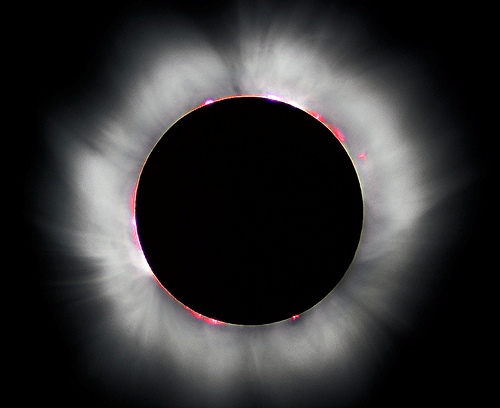
The eclipse is seen initially in India and it traverses through Nepal, Bangladesh, Bhutan and China and across the Pacific Ocean. Hence the major part of the eclipse occurs at eastern Asia, Indonesia and Pacific Ocean.
It is safe to observe the total phase of a solar eclipse directly with the unaided eye, binoculars or a telescope, when the sun is completely covered by the Moo. In fact this cannot be viewed thorough the filters as the light will be very dim. At this point of total solar eclipse the sun will be completely hidden and just a ring will visible which is nothing but the corona of the sun.

When the shrinking visible part of the photosphere becomes very small, Baily’s beads will occur. It has been named so as the image formed because of the sun rays looks like beads. This is caused by the sunlight still being able to reach Earth through lunar valleys, but no longer where mountains are present. After this begins the Totality with the Diamond Ring Effect, which emits the last bright flash of sunlight.
Occurrences
The following are few of the places where the total solar eclipse on 22nd July 2009 can be experienced. All timings mentioned here are local timings of that place.
| Location | Start Time | End Time | Maximum Eclipse at |
| India | 05:54 | 07:18:11 | 06:21:00 |
| Bangladesh | 05:59:16 | 08:04:39 | 06:58:14 |
| Japan | 09:55:39 | 12:30:19 | 11:13:00 |
| Singapore | 08:40:52 | 09:43:56 | 09:11:26 |
| Indonesia | 16:20:18 | 18:50:14 | 17:40:54 |
| China | 08:33:45 | 10:54:09 | 09:41:59 |
Photography
Photographing such total solar eclipse is possible with fairly common film camera equipment. In order for the disk of the sun/moon to be easily visible, a fairly high magnification telephoto lens is needed (70-200 mm for a 35 mm camera), and for the disk to fill most of the frame, a longer lens is needed (over 500 mm). For those who are interested in photographing the total solar eclipse, here are few tips to make your photographing fruitful.
Precautions
Viewing the Sun after totality can be dangerous. Hence do not view the sun after eclipse as it emits highly hazardous rays.
While in Photographing, do take proper precautions to safeguard your eyes. The sun when viewed through the view finder of the camera might affect the retina of the eyes, which might even be a cause for losing our eyes. One of the most widely available filters for safe solar viewing is shade number 14 welder’s glass, which can be obtained from welding supply outlets.
0 comments:
Post a Comment